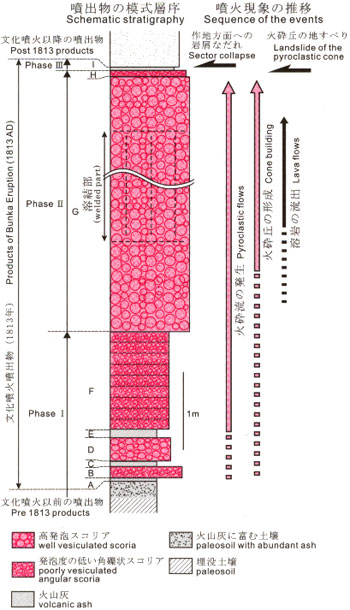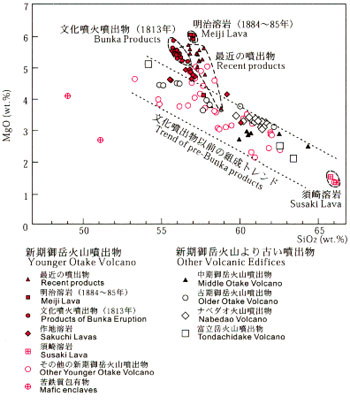Suwanosejima Volcano
1: Introduction / 2: The topography of Suwanosejima Volcano
3: Geological history
4: Products during the historical age / 5: Petrology
6: Recent activities
7: Geophysical observations / 8: Characteristics of the recent activity and hazards
References
![]() PREV
PREV ![]() NEXT
NEXT
4: Products during the historical age / 5: Petrology
4: Products during the historical age
The historical records of eruptions are limited to those around the 1813 eruption and some recent activities. The deposits by these activities belong to Younger Otake Volcano.
4.1 Sequence and products of the 1813 eruption
The 1813 eruption (Bunka Eruption) was a large explosive eruption from the crater chain on the ridge extending from the summit of Otake to the SSW direction. The volume of erupted products are estimated to be up to the order of 108 m3 DRE, judging approximately from the distribution of the deposit on land (Shimano and Koyaguchi, 2001). The erupted magma was basaltic andesite in whole rock chemical composition with ca. 56 wt.% of SiO2.
Shimano and Koyaguchi (2001) classified the sequence of this eruption into Phases I to III based on the characteristics of the deposit (![]() Figs. 6,
Figs. 6, ![]() 7). The eruption started with the alternation of minor phreatomagmatic and strombolian eruptions along fissure vents on the southern flank of Otake Volcano (Phase I). Then the fissure propagated toward the summit crater, which resulted in a sub-Plinian eruption (Phase II). A large edifice collapse occurred in the last stage of the eruption (Phase III).
7). The eruption started with the alternation of minor phreatomagmatic and strombolian eruptions along fissure vents on the southern flank of Otake Volcano (Phase I). Then the fissure propagated toward the summit crater, which resulted in a sub-Plinian eruption (Phase II). A large edifice collapse occurred in the last stage of the eruption (Phase III).
The distribution of the deposits of Phase I is concentrated to the southern part of the island due to the eruption at fissures or craters near Tongama (Unit A-F, in ![]() Figs. 6,
Figs. 6, ![]() 7). This activity formed a small pyroclastic cone near Tongama. The products of Phase I are characterized by alternation of many scoria lapilli and ash fall layers of different vesicularity. A part of the cone collapsed several times since the last stage of Phase I toward the end of this eruption, which resulted in some pyroclastic flows that covered the village area and reached to the coast.
7). This activity formed a small pyroclastic cone near Tongama. The products of Phase I are characterized by alternation of many scoria lapilli and ash fall layers of different vesicularity. A part of the cone collapsed several times since the last stage of Phase I toward the end of this eruption, which resulted in some pyroclastic flows that covered the village area and reached to the coast.
In the climactic phase, Phase II, the eruption fissure enlarged to the area from Tongama through Kyukako to Otake crateres, and the activity sifted to a sub-Plinian eruption accompanied by a fire fountain. A pyroclastic cone consisting of highly welded agglutinate was formed with a maximum thickness of ca 80 m and a wide distribution of ca 20 km2, while a vesicular scoria fall deposit covered the entire island (Unit G in ![]() Figs. 6,
Figs. 6, ![]() 7). Some pyroclastic flows ran down to around Teisaibama on the southeastern shore and to around Sakuchi area in the southern part of Sakuchi Caldera. Lava was also effused from around Kyukako crater and flowed down to Akazumi and Taisenbama coast.
7). Some pyroclastic flows ran down to around Teisaibama on the southeastern shore and to around Sakuchi area in the southern part of Sakuchi Caldera. Lava was also effused from around Kyukako crater and flowed down to Akazumi and Taisenbama coast.
A part of the pyroclastic cone formed on the steep slope of the edifice resulted in remobilization in the form of a landslide during or just after the deposition between Phases II and III (Shimano and Koyaguchi, 2001). The landslide deposits formed lobes similar to lava flows, the largest of which flowed down the western slope of Otake crater to Suigo beach. Many other, smaller-scale surface topographic features formed by remobilization, such as crevasses and cliffs, are found on the surface of the pyroclastic cone.
Phase III is characterized by a large-scale collapse of the volcanic edifice, which occurred in the last stage of the eruption. Debris avalanche occurred from near Otake crater toward the shore of Sakuchi. The deposit is as thick as ca. 10 m at the shore, and can be divided into three units based on their lithofacies and colors.
4.2 Sequence and products of the 1884-85 eruption (Meiji Eruption)
An explosion occurred in October of 1884, which was followed by pumice and ash fall on the island and then by effusion of lava flows from Otake crater (Meiji Lava). The eruption seems to have lasted until February of 1885. We could not find the pumice fall deposit of this eruption in the village area, but there is a pumice layer near the summit of Otake that could be correlated with this eruption. Small portions of the pyroclastic cone of the present Otake crater (ca. 450 in diameter) seem to have been formed at this time, judging from some records in the Meiji era. The lava flow covers a wide area from Otake crater toward the shoreline of Kurogai in Sakuchi Caldera. Many flow lobes have developed on the surface of the lava flow. Ropy wrinkles are developed on some of these lobes implying that they flew like pahoehoe lava.
4.3 Products after the 1884-85 eruption to present
The activity after the Meiji eruption is characterized by small-scale vulcanian, strombolian, and ash-emitting eruptions. The vulcanian eruptions of Suwanosejima Volcano feature an explosion of a short duration, with ash plumes and a small amount of volcanic bombs that can fall in the area a few kilometers from Otake crater. The bombs are dense blocks or bread-crust bombs. The strombolian eruptions are characterized by intermittent emissions of incandescent magmatic fragments. In an active period, such as in 2010, highly vesicular and low-crystallinity golden scoria and flaky bombs are erupted by strombolian eruptions. Some eruptions with continuous ash emission are called ash eruptions. The products of an ash eruption consist of scoria fragments of various vesicularity, as well as fragments of dense rock and crystals, most of which are fresh and probably essential materials.
The Otake Pyroclastic Cone, with a diameter and height of ca. 600 m and 80 m, respectively, was formed by these activities at Otake crater. The distal ash fall deposit by this activity covers the whole island (Imura, 1991), with a thickness of a few meters and 0.5-1 m near the summit and in the village 4 km south of the crater, respectively.
5: Petrology
The products of Suwanosejima Volcano are basaltic andesite to dacite with SiO2 of 55-67 wt.%. Three compositional trends in variation are observed in the SiO2-MgO diagram (![]() Fig. 8). (1) The 1884-85 lava has the most primitive composition in Suwanosejima Volcano and has high MgO content; most of the products of recent activity belong to this trend. (2) The 1813 products are at the mafic-end of a compositional trend in which Sakuchi lavas belong. (3) The third indicates some parallel trends in which the mafic and felsic end members are lavas of Tondachidake Volcano and Susaki Lava, respectively; most of the products of Older to Young Otake volcanoes belong to this group. These compositional trends were formed by the fractional crystallizations and magma mixings with two – three end members.
Fig. 8). (1) The 1884-85 lava has the most primitive composition in Suwanosejima Volcano and has high MgO content; most of the products of recent activity belong to this trend. (2) The 1813 products are at the mafic-end of a compositional trend in which Sakuchi lavas belong. (3) The third indicates some parallel trends in which the mafic and felsic end members are lavas of Tondachidake Volcano and Susaki Lava, respectively; most of the products of Older to Young Otake volcanoes belong to this group. These compositional trends were formed by the fractional crystallizations and magma mixings with two – three end members.
The amount of phenocrysts in the products of Suwanosejima Volcano is 19-43 vol.%. Phenocrysts consist mainly of plagioclase and small amounts of orthopyroxene, clinopyroxene, and magnetite. Some samples have a trace amount of olivine, and some historical products after the 1813 eruption do not have magnetite phenocrysts.


